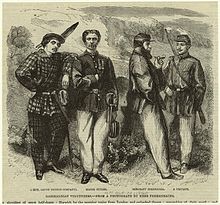
The unification of Italy, also known as the Risorgimento, was the 19th-century political and social movement that resulted in 1861 in the consolidation of various states of the Italian Peninsula and its outlying isles into a single state, the Kingdom of Italy. Inspired by the rebellions in the 1820s and 1830s against the outcome of the Congress of Vienna, the unification process was precipitated by the Revolutions of 1848, and reached completion in 1871 after the capture of Rome and its designation as the capital of the Kingdom of Italy.

Agostino Depretis was an Italian statesman and politician. He served as Prime Minister of Italy for several stretches between 1876 and 1887, and was leader of the Historical Left parliamentary group for more than a decade. He is the fourth-longest serving Prime Minister in Italian history, after Benito Mussolini, Giovanni Giolitti and Silvio Berlusconi, and at the time of his death he was the longest-served. Depretis is widely considered one of the most powerful and important politicians in Italian history.
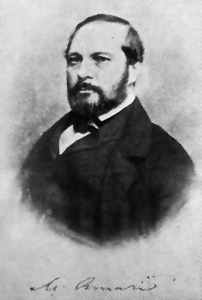
Michele Benedetto Gaetano Amari was a Sicilian patriot, liberal revolutionary and politician of aristocratic background, historian and orientalist. He rose to prominence as a champion of Sicilian independence from the Neapolitan Bourbon rule when he published his history of the War of the Sicilian Vespers in 1842. He was a minister in the Sicilian revolutionary government of 1848–9 and in Garibaldi's revolutionary cabinet in Sicily in 1860. Having embraced the cause of Italian unification, he helped prepare the annexation of Sicily by the Kingdom of Sardinia and was active in his later years as a senator of the Kingdom of Italy.

The Expedition of the Thousand was an event of the unification of Italy that took place in 1860. A corps of volunteers led by Giuseppe Garibaldi sailed from Quarto al Mare near Genoa and landed in Marsala, Sicily, in order to conquer the Kingdom of the Two Sicilies, ruled by the Spanish House of Bourbon-Two Sicilies. The name of the expedition derives from the initial number of participants, which was around 1,000 people.

The Sicilian revolution of independence of 1848 which commenced on 12 January 1848 was the first of the numerous Revolutions of 1848 which swept acrosss Europe. It was a popular rebellion against the rule of Ferdinand II of the House of Bourbon, King of the Two Sicilies. Three revolutions against the Bourbon ruled Kingdom of the Two Sicilies had previously occurred on the island of Sicily starting from 1800: this final one resulted in an independent state which survived for 16 months. The Sicilian Constitution of 1848 which survived the 16 months was advanced for its time in liberal democratic terms, as was the proposal of a unified Italian confederation of states. It was in effect a curtain-raiser to the end of the Bourbon kingdom of the Two Sicilies, finally completed by Giuseppe Garibaldi's Expedition of the Thousand in 1860, the Siege of Gaeta of 1860–1861 and the proclamation of the unified Kingdom of Italy.
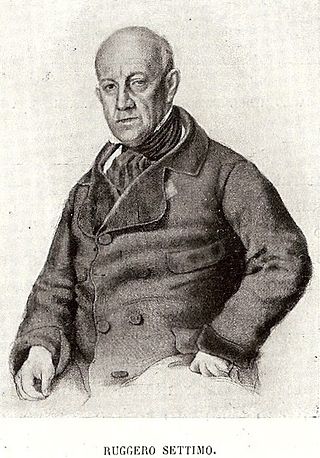
Ruggero Settimo was an Italian politician, diplomat, and patriotic activist from Sicily. He was a counter-admiral of the Sicilian Fleet. He fought alongside the British fleet in the Mediterranean Sea against the French under Napoleon Bonaparte. He reconquered the island of Malta, and defended the city of Gaeta near Naples.
This is a timeline of the unification of Italy.
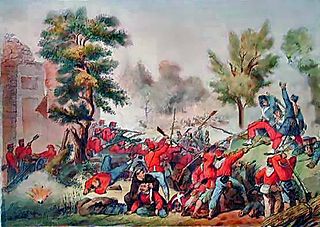
The Battle of the Volturno refers to a series of military clashes between Giuseppe Garibaldi's volunteers and the troops of the Kingdom of Two Sicilies occurring around the River Volturno, between the cities of Capua and Caserta in northern Campania, in September and October 1860. The main battle took place on 1 October 1860 between 30,000 Garibaldines and 25,000 Bourbon troops (Neapolitans).

The Battle of Milazzo was fought on 17–24 July 1860 between Giuseppe Garibaldi's volunteers and the troops of the Kingdom of Two Sicilies at Milazzo, Sicily, then part of the Kingdom of Two Sicilies.

Giuseppe Maria Garibaldi was an Italian general, patriot, revolutionary and republican. He contributed to Italian unification (Risorgimento) and the creation of the Kingdom of Italy. He is considered to be one of Italy's "fathers of the fatherland", along with Camillo Benso, Count of Cavour, Victor Emmanuel II of Italy and Giuseppe Mazzini. Garibaldi is also known as the "Hero of the Two Worlds" because of his military enterprises in South America and Europe.
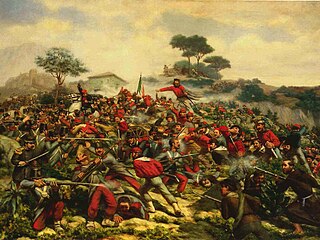
The Battle of Calatafimi was fought on the 15 May 1860 between Giuseppe Garibaldi's Redshirts and the troops of the Kingdom of the Two Sicilies at Calatafimi, Sicily, as part of the Expedition of the Thousand. The battle was the first of Garibaldi's victory during his invasion of Sicily in 1860 and saw his 'Thousand' defeat a larger Neapolitan army sent from Palermo to block the roads to the Sicilian capital.

Giuseppe De Felice Giuffrida was an Italian socialist politician and journalist from Sicily. He is considered to be one of the founders of the Fasci Siciliani a popular movement of democratic and socialist inspiration. As the first socialist mayor of Catania in Sicily, from 1902 until 1914, he became the protagonist of a kind of municipal socialism.

The Dictatorship of Garibaldi or Dictatorial Government of Sicily was the provisional executive that Giuseppe Garibaldi appointed to govern the territory of Sicily during the Expedition of the Thousand in 1860. It governed in opposition to the Bourbons of Naples.

The British Legion was a military corps composed of English and Scottish volunteers, who in 1860 joined Giuseppe Garibaldi during the Expedition of the Thousand and fought for the unification of Italy, together with the Italian Redshirts, as part of their Southern Army against the Bourbon Army of the Kingdom of the Two Sicilies.

Antonio Mordini was a longstanding Italian patriot and, after 1861, a member of the Parliament of the Kingdom of Italy. In 1869 he served as Minister of Public Works of the Kingdom of Italy, a member of the third Menabrea government.

Giacinto Carini was a politician and Italian patriot. He participated in the Sicilian independence revolution of 1848, was a Garibaldian, a general, and a member of Parliament.

The siege of Palermo took place between 27 and 30 May 1860 in Palermo, Sicily, during the Expedition of the Thousand led by Giuseppe Garibaldi against the Kingdom of the Two Sicilies, as part of the Italian unification wars.

Francesco Landi was a Two Sicilian Brigadier General who was notable for being the main commander at the Battle of Calatafimi against Garibaldi's Redshirts during the Expedition of the Thousand.
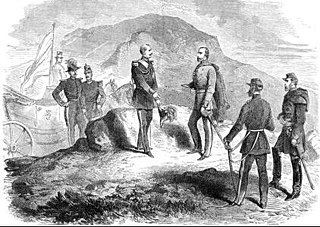
Ferdinando Lanza was a Two Sicilian lieutenant-general who fought against Garibaldi's Expedition of the Thousand. During the conflict, Lanza was stationed at Palermo but surrendered after the siege on May 30, 1860.
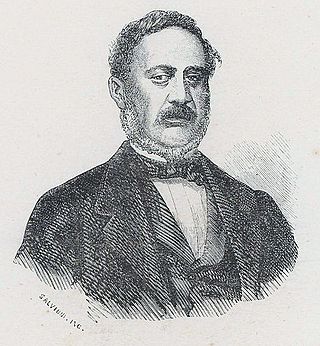
Filippo Cordova was an Italian patriot, jurist and politician.

